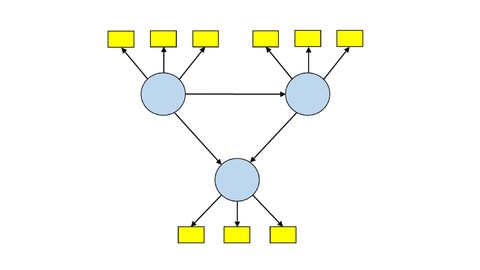
New Capabilities in PLS Path Modeling
New Capabilities in PLS Path Modeling, available at $19.99, has an average rating of 4.05, with 145 lectures, based on 10 reviews, and has 777 subscribers.
You will learn about Students will learn about recent advances in estimating PLS path models. Students will learn about the PLS algorithm, about consistent PLS, and about adding non-linear terms to a PLS model. Students will understand how to perform multi-group analysis (MGA) with any number of groups. Students will learn how to discover sources of heterogeneity using FIMIX, PLS-POS and PLS-GAS. Students will learn how to accurately estimate direct, indirect, and total effects, especially in the presence of complex mediating and moderating influences. Students will learn new ways to perform bootstrapping, jackknifing, and blindfolding resampling approaches. Students will learn new ways to visualize relationships in PLS path models. This course is ideal for individuals who are Anyone involved in PLS path modeling will benefit from this course. or Graduate students, college and university faculty, and working professionals involved in variance-based path modeling will benefit from this course. It is particularly useful for Anyone involved in PLS path modeling will benefit from this course. or Graduate students, college and university faculty, and working professionals involved in variance-based path modeling will benefit from this course.
Enroll now: New Capabilities in PLS Path Modeling
Summary
Title: New Capabilities in PLS Path Modeling
Price: $19.99
Average Rating: 4.05
Number of Lectures: 145
Number of Published Lectures: 145
Number of Curriculum Items: 145
Number of Published Curriculum Objects: 145
Original Price: $29.99
Quality Status: approved
Status: Live
What You Will Learn
- Students will learn about recent advances in estimating PLS path models.
- Students will learn about the PLS algorithm, about consistent PLS, and about adding non-linear terms to a PLS model.
- Students will understand how to perform multi-group analysis (MGA) with any number of groups.
- Students will learn how to discover sources of heterogeneity using FIMIX, PLS-POS and PLS-GAS.
- Students will learn how to accurately estimate direct, indirect, and total effects, especially in the presence of complex mediating and moderating influences.
- Students will learn new ways to perform bootstrapping, jackknifing, and blindfolding resampling approaches.
- Students will learn new ways to visualize relationships in PLS path models.
Who Should Attend
- Anyone involved in PLS path modeling will benefit from this course.
- Graduate students, college and university faculty, and working professionals involved in variance-based path modeling will benefit from this course.
Target Audiences
- Anyone involved in PLS path modeling will benefit from this course.
- Graduate students, college and university faculty, and working professionals involved in variance-based path modeling will benefit from this course.
Over the past several years, a significant number of new PLS path modeling (PLS-PM) approaches, techniques, and capabilities have been published in the leading academic and scientific journals. As a methodological field, variance-based path modeling with latent variables has witnessed more new, published technological advancements and developments than in the preceding two decades.
This 7-session course teaches many of these new concepts and how to specify and model them with various PLS path modeling softwares available today. All of the demonstrated softwares, some as trial versions, are freely available to use as of the publication date of this Udemy course. Use the convenient new over-the-Internet PLS-GUI “Software as a Service” (SaaS) path modeling software platform with the capability to perform PLS-PM from any computer in the world using only a browser. Securely access, upload and/or download, and reliably estimate your PLS data files and/or modify and manipulate your PLS project and model files from any computer in the world. In addition to providing the convenience and speed of using the PLS-GUI SaaS platform, the workshop also instructs with respect to using the new ADANCO composite modeling PLS software which participants may install on their Windows or Mac computer.
This is a “hands-on” course which explains the basis of many new PLS path modeling estimation capabilities and features, and which then proceeds to demonstrate numerous examples of these new capabilities and features using various PLS path modeling packages. All of the demonstrated software, some as trial versions, are freely available to use as of the publication date of this course.�
New PLS-PM capabilities and features which are explained and demonstrated include consistent PLS and non-linear PLS algorithm estimation, N-group multi-group analysis (MGA), prediction-oriented segmentation (PLS-POS) and genetic-algorithm segmentation (PLS-GAS), and new visualizations for illustrating latent variable and measurement item relationships. New approaches and techniques for estimating complex mediating and moderating relationships are explained and demonstrated. Also covered are a variety of new resampling techniques applicable to PLS-PM with bootstrapping, jackknifing, and blindfolding.
It is useful, but not essential, to have some knowledge of PLS path modeling before you take this course. However, even novice PLS path modelers will benefit from the course’s content.
Course Curriculum
Chapter 1: Introduction to Course: Objectives, Purpose and Agenda
Lecture 1: Overview of Course
Lecture 2: A Few Words about the Course and the Materials (part 1)
Lecture 3: A Few Words about the Course and the Materials (part 2)
Lecture 4: What does this Course Teach? (part 1)
Lecture 5: What does this Course Teach? (part 2)
Lecture 6: Agenda (part 1)
Lecture 7: Agenda (part 2)
Lecture 8: Agenda (part 3)
Lecture 9: Agenda (part 4)
Lecture 10: Agenda (part 5)
Lecture 11: PLS-GUI Capabilities (part 1)
Lecture 12: PLS-GUI Capabilities (part 2)
Lecture 13: PLS-GUI Capabilities (part 3)
Lecture 14: PLS-GUI Capabilities (part 4)
Lecture 15: PLS-GUI Capabilities (part 5)
Lecture 16: Drawing a PLS-GUI Model (part 1)
Lecture 17: Drawing a PLS-GUI Model (part 2)
Lecture 18: Importing Models and Projects (part 1)
Lecture 19: Importing Models and Projects (part 2)
Lecture 20: Importing Models and Projects (part 3)
Chapter 2: Linear PLS and Interaction Terms with PLS-GUI
Lecture 1: Introduction to Linear PLS Session
Lecture 2: Importing Projects Again (part 1)
Lecture 3: Importing Projects Again (part 2)
Lecture 4: Linear Modeling (part 1)
Lecture 5: Linear Modeling (part 2)
Lecture 6: Assessing Reliability and Validity (part 1)
Lecture 7: Assessing Reliability and Validity (part 2)
Lecture 8: Assessing Reliability and Validity (part 3)
Lecture 9: Assessing Reliability and Validity (part 4)
Lecture 10: More on Linear PLS Reports (part 1)
Lecture 11: More on Linear PLS Reports (part 2)
Lecture 12: More on Linear PLS Reports (part 3)
Lecture 13: More on Linear PLS Reports (part 4)
Lecture 14: More on Linear PLS Reports (part 5)
Lecture 15: Super Bootstrapper (part 1)
Lecture 16: More Bootstrapping and Interactions
Lecture 17: More on Interactions
Chapter 3: PLS Algorithm Advances
Lecture 1: Advances in the PLS Algorithm Introduction
Lecture 2: PLS Algorithm Review (part 1)
Lecture 3: PLS Algorithm Review (part 2)
Lecture 4: PLS Algorithm Review (part 3)
Lecture 5: PLS Algorithm Review (part 4)
Lecture 6: PLS Algorithm Review (part 5)
Lecture 7: PLS Algorithm Review (part 6)
Lecture 8: ADANCO Software Algorithm (part 1)
Lecture 9: ADANCO Software Algorithm (part 2)
Lecture 10: Consistent PLS (part 1)
Lecture 11: Consistent PLS (part 2)
Lecture 12: Consistent PLS (part 3)
Lecture 13: More on Linear PLS (part 1)
Lecture 14: More on Linear PLS (part 2)
Lecture 15: More on Linear PLS (part 3)
Lecture 16: More on Linear PLS (part 4)
Lecture 17: Non-Linear Effects (part 1)
Lecture 18: Non-Linear Effects (part 2)
Chapter 4: Groups and Latent Segmentation
Lecture 1: Introduction to Group Differences
Lecture 2: Group Differences (part 1)
Lecture 3: Group Differences (part 2)
Lecture 4: Group Differences (part 3)
Lecture 5: Group Differences (part 4)
Lecture 6: Group Differences (part 5)
Lecture 7: Groups (part 6)
Lecture 8: Groups (part 7)
Lecture 9: Groups (part 8)
Lecture 10: Groups (part 9)
Lecture 11: Assessing Interactions with PLS-GUI SaaS (part 1)
Lecture 12: Assessing Interactions with PLS-GUI SaaS (part 2)
Lecture 13: Multi-Group Analysis Considerations (part 1)
Lecture 14: Interactions with SmartPLS 3.0+ (part 1)
Lecture 15: Interactions with SmartPLS 3.0+ (part 2)
Lecture 16: Interactions with PLS-GUI (part 1)
Lecture 17: Interactions with PLS-GUI (part 2)
Lecture 18: Heterogeneous Segments (part 1)
Lecture 19: Heterogeneous Segments (part 2)
Lecture 20: Heterogeneous Segments (part 3)
Lecture 21: Approaches to Segmentation
Lecture 22: Segmentation in Depth (part 1)
Lecture 23: More on FIMIX (part 1)
Lecture 24: More on FIMIX (part 2)
Lecture 25: More on FIMIX (part 3)
Lecture 26: More on FIMIX (part 4)
Lecture 27: PLS-POS (part 1)
Lecture 28: PLS-POS (part 2)
Lecture 29: PLS-POS (part 3)
Lecture 30: PLS-POS (part 4)
Lecture 31: PLS-POS (part 5)
Chapter 5: New Visualizations for PLS Path Modeling
Lecture 1: Setting Up Latent Variable Cross Correlation Tables (part 1)
Lecture 2: Setting Up LV Cross Correlation Tables (part 2)
Lecture 3: PLS Tables for Visualizations (part 3)
Lecture 4: Cross Correlation Plots (part 1)
Lecture 5: Cross Correlation Plots (part 2)
Lecture 6: Cross Correlation Plots (part 3)
Lecture 7: Cross Correlation Plots (part 4)
Lecture 8: A Question About Dropping Items
Chapter 6: Mediation, Moderation, and Conditional PROCESS Analysis
Instructors
-
Geoffrey Hubona, Ph.D.
Associate Professor of MIS and Data Analytics
Rating Distribution
- 1 stars: 0 votes
- 2 stars: 1 votes
- 3 stars: 2 votes
- 4 stars: 5 votes
- 5 stars: 2 votes
Frequently Asked Questions
How long do I have access to the course materials?
You can view and review the lecture materials indefinitely, like an on-demand channel.
Can I take my courses with me wherever I go?
Definitely! If you have an internet connection, courses on Udemy are available on any device at any time. If you don’t have an internet connection, some instructors also let their students download course lectures. That’s up to the instructor though, so make sure you get on their good side!
You may also like
- Best Investing Courses to Learn in March 2025
- Best Personal Finance Courses to Learn in March 2025
- Best Health And Wellness Courses to Learn in March 2025
- Best Chatgpt And Ai Tools Courses to Learn in March 2025
- Best Virtual Reality Courses to Learn in March 2025
- Best Augmented Reality Courses to Learn in March 2025
- Best Blockchain Development Courses to Learn in March 2025
- Best Unity Game Development Courses to Learn in March 2025
- Best Artificial Intelligence Courses to Learn in March 2025
- Best Flutter Development Courses to Learn in March 2025
- Best Docker Kubernetes Courses to Learn in March 2025
- Best Business Analytics Courses to Learn in March 2025
- Best Excel Vba Courses to Learn in March 2025
- Best Devops Courses to Learn in March 2025
- Best Angular Courses to Learn in March 2025
- Best Node Js Development Courses to Learn in March 2025
- Best React Js Courses to Learn in March 2025
- Best Cyber Security Courses to Learn in March 2025
- Best Machine Learning Courses to Learn in March 2025
- Best Ethical Hacking Courses to Learn in March 2025






















